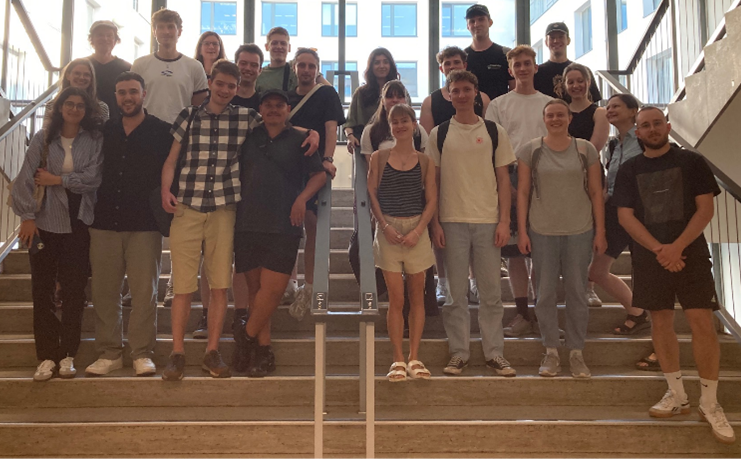Climate change adaptation and democracy in Vienna
From June 3 to 6, the first part of the comparative excursion “Democracy and Climate Change Adaptation in Berlin and Vienna” took place, organized by the Department of Geography and Regional Research at the University of Vienna in collaboration with the Department of Geography at Humboldt University of Berlin (HU-B). Twelve students from HU-B, accompanied by Prof. Dr. Henning Nuissl, traveled to Vienna and, together with ten students from the University of Vienna led by Prof. Dr. Kerstin Krellenberg and Dr. Julia Wesely, explored various initiatives at the intersection of climate change adaptation and democracy.
The central question was how urban transformations can not only be sustainable and adapted to climate change but also democratically legitimized and shaped. The excursion also aimed to foster comparative reflections between Berlin and Vienna, which will be further developed during the second part of the excursion in July in Berlin. Both the University of Vienna and HU-B are members of the Circle U. Alliance, a network of nine European universities committed to cooperative teaching and research on climate, democracy, and global health. Aileen Pohl accompanied and supported the excursion team to document and evaluate this innovative format.
The “Course Guide: Lessons Learned from a Circle U. Collaborative Field Trip” synthesizes the documentation and reflections for anyone interested in developing a similar comparative course.
The excursion was structured around five thematic areas, each led by student groups for a half-day session:
-
Environmental Justice and Climate-Just Cities (Astrid Pohl, Clemens Jellmair)
-
Direct Democracy (Piotr Jantos, Matthias Altmann)
-
Citizen Participation (Jakob Kühnberger, Christoph Kaiser)
-
Tactical Urbanism (Marie Aglas, Hanna Eckel)
-
Scalar Dimensions (Áron Horváth, Albert Pranger)
Students also participated in the Circle U. Climate Day at the University of Vienna, where they learned about participatory climate justice through initiative showcases, flash talks, and a panel discussion.
Here you can read thematic reflections of the Viennese and Berlin students in the form of individual blog posts (only available in German).
The excursion began with a (sensory) walk through Vienna’s 20th district, Brigittenau, where the topic of climate justice was explored using factors like noise, traffic calming, and access to green space in densely built-up areas. Highlights included a green inner courtyard in a public housing complex, a facade greening in Hannovergasse, and the redesigned, now traffic-calmed Treustraße with new greenery and seating areas. The walk ended with an expert talk by Simon Büchler from the local district management team, who introduced the students to the “Gartln ums Eck” project on Jägerstraße. To wrap up the topic, the students visited the redesigned Pelzgasse in the 15th district and the rooftop of IKEA Westbahnhof, where they discussed tensions between public and private space in climate adaptation efforts—with a beautiful view over Vienna.
Die zweite Studierendengruppe organisierte ein Gespräch mit Jana Plöchl von der BOKU University, die den Prozess des österreichischen Klimarats sozialwissenschaftlich begleitete. In der Diskussion um deliberative Demokratie waren vor allem Moderationsmethoden, die Bedeutung eines respektvollen Diskussionsklimas, das Auswahlverfahren der Teilnehmer*innen und das Thema Inklusion für die Studierenden von Interesse. Die Expertin betonte, dass viele Teilnehmende sich durch den Klimarat erstmals politisch wirksam fühlten, es aber auch Enttäuschung über fehlende Umsetzung der erarbeiteten Ergebnisse gab.
Im Anschluss vertieften die Wiener Studierenden das Thema mit einem Planspiel zum kontroversiellen Beispiel des Lobautunnels. Dafür nahmen die Berliner Studierenden verschiedene Perspektiven ein und entwickelten Argumente für oder gegen eine Volksabstimmung zum Bau des Lobautunnels.
The second excursion day began with a walk through the 15th district, focusing on the ongoing redesign of the climate-resilient outer Mariahilfer Straße and a “Grätzloase” (neighborhood oasis) in Reindorfgasse. This was followed by a visit to the district management office, where Bea Vogler-Kautz and Daniel Dutkowski spoke about their work at the interface of neighborhood engagement, administration, and residents’ everyday concerns. In response to student questions, they noted that climate adaptation is rarely addressed directly but is reflected in everyday issues like “My apartment is too hot” or “I can’t find a shady place to sit.” The group then visited Dadlerpark, where topics like community gardening, quality of stay, and neighborhood dynamics intersect. The students presented the Vienna Climate Team—a democratic participation format that involves citizens in the design of climate-relevant projects. The Berlin students developed their own project ideas for climate adaptation in the district, with a popular proposal being to turn Reindorfgasse into a car-free market zone on weekends.
The “Supergrätzl,” a pilot project by the City of Vienna, served as a case study for tactical urbanism. With the help of an audio guide and e-book, Berlin students gained insight into the project’s development and participation process over the past years. They then explored the “Supergrätzl” from the perspectives of different interest groups (children, youth, adults, seniors), developed their own improvement suggestions, and marked them with sidewalk chalk. Despite varied focuses, a shared cross-generational vision emerged: Public space that supports movement, social encounters, and heat protection through greening, water fountains, and non-commercial gathering spots. The day ended with a discussion in Erlachpark, centering about the questions who uses the newly designed space—and who might no longer feel welcome. It became clear that climate adaptation and public space redesign can lead to displacement. To avoid this, space for appropriation should remain, allowing local residents to respond to changing needs.
On the final day of the excursion, the group visited the Urban Innovation Vienna (UIV) office, where Petra Schöfmann presented the “Raus aus Gas” project and answered questions about its implementation. The discussion made it clear that legal frameworks and financial resources are key challenges regarding the decarbonization of the building sector. With the aim of enabling a more structured approach, the Vienna Heating Plan was developed, outlining when and where neighborhoods will be connected to the district heating network to avoid “unnecessary” construction and promote integrated planning. Ms. Schöfmann emphasized that centralized solutions are often more efficient in the long term than many individual ones.
This first part of the joint excursion in Vienna offered rich insights into the challenges and potentials of participatory urban design in the context of the climate crisis. The students’ contributions repeatedly highlighted the importance of producing local knowledge and democratic negotiation processes. While individual measures cannot offer universal solutions, they can demonstrate how climate adaptation can be shaped in synergy with social action. Climate justice arises when diverse perspectives are included, local needs are genuinely addressed, and urban environments remain accessible for collective use and appropriation.
In their final reflections, students noted similarities between Vienna and initiatives in Berlin, such as traffic-calmed neighborhoods that also promote community. However, they also observed differences in local governance structures, legal frameworks, and citizen engagement—which will be further explored during the second part of the excursion in Berlin in July.
Text: Aileen Pohl, 2025





















